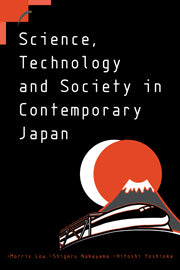Freshly Printed - allow 4 days lead
Couldn't load pickup availability
Science, Technology and Society in Contemporary Japan
This is an introductory-level text exploring science and technology in Japanese society.
Morris Low (Author), Shigeru Nakayama (Author), Hitoshi Yoshioka (Author)
9780521652827, Cambridge University Press
Hardback, published 28 November 1999
240 pages, 5 b/w illus. 5 tables
23.7 x 15.8 x 2.5 cm, 0.59 kg
'As late as August 1998, Japanese prime minister Keizo Obuchi was unaware of the Y2K bug. That the leader of one of the world's most technologically advanced nations should have been ignorant of such a serious problem may come as a surprise. But it is one of many contained in a new book, Science, Technology, and Society in Contemporary Japan. Did you know, for example, that Japan has the worst dioxin contamination in the world? Or that the Japanese spend twice as much on prescription drugs as on rice? The warts-and-all picture of Japan that emerges from the book is very different from the glistening high-tech stereotype. It is painted by Morris Low, a senior lecturer at the University of Queensland, and two Japanese co-authors, Shigeru Nakayama, the preeminent historian of Japanese science, and his former student, Hitoshi Yoshioka' New Scientist
This book explores the dynamic relationship between science, technology and Japanese society, examining how it has contributed to economic growth and national well-being. It presents a synthesis of recent debates by juxtaposing competing views about the role and direction of science, technology and medical care in Japan. Topics discussed include government policy, the private sector and community responses; computers and communication; the automobile industry, the aerospace industry and quality control; the environment; consumer electronics; medical care; and the role of gender. This is an ideal introductory text for students in the sociology of science and technology, the history and philosophy of science, and Japanese studies. Up-to-date research and case studies make this an invaluable resource for readers interested in the nature of science and technology in the twenty-first century.
Part I. The Japanese Model of R & D: 1. Basic versus applied research: the role of corporate laboratories and universities
2. Cooperation versus competition: Miti's R & D projects and Japan's science cities
Part II. Science and Technology for Economic Growth: 3. Quality versus quantity: the automobile industry
4. Technology versus commercial feasibility: nuclear power and electric utilities
5. Consumerism and development versus the environment
Part III. The International Dimension: 6 Domestic development versus importation of technology: the aerospace industry and the FS-X fighter plane controversy
7 Domestic technology versus the export of technology
Part IV. Science and Technology for the People? 8. Information society versus controlled society
9. Women versus men in the science and technology workforce
10. National interest versus local interests: the construction of Narita airport
11. The patient versus the doctor: changes in medical care and attitudes to the body.
Subject Areas: 20th century history: c 1900 to c 2000 [HBLW], Asian history [HBJF]


